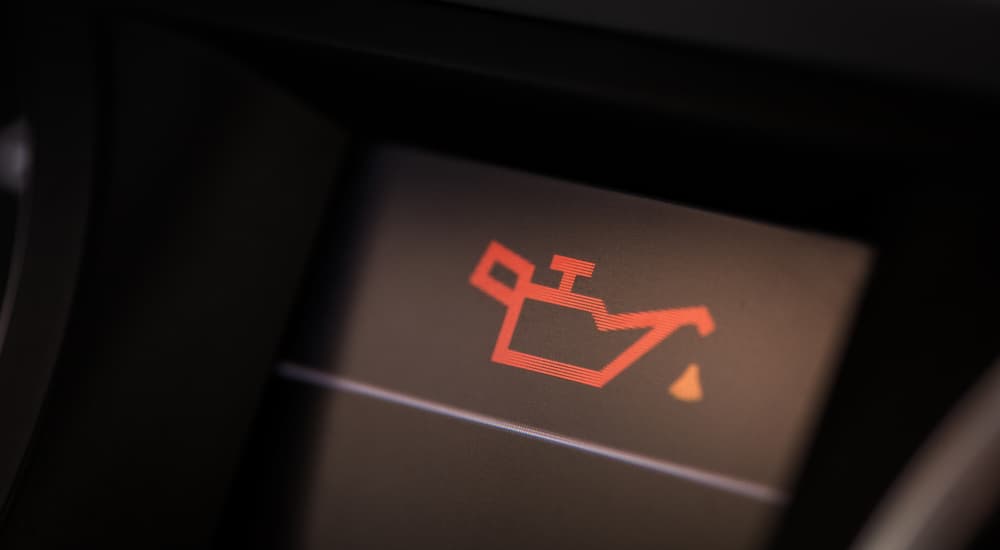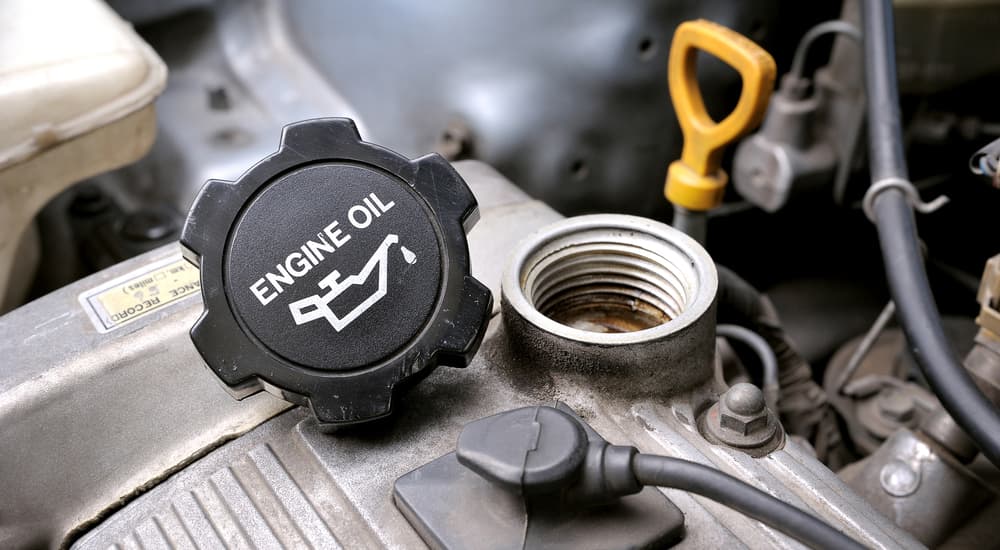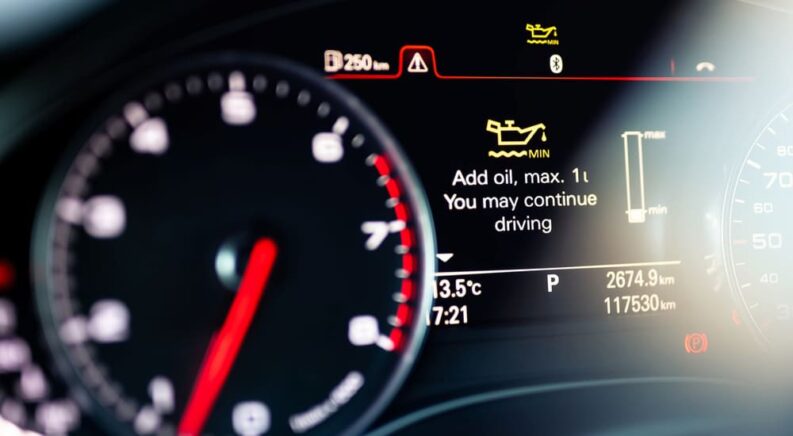Today’s gas-powered vehicles are a marvel of modern engineering, with hundreds of parts working in perfect harmony to push your car, truck, or SUV forward. With so many components—many of them metal—operating in such close proximity, lubrication is key to reducing the friction between these parts, aiding in performance, and keeping your engine from tearing itself apart.
Proper oil pressure is key to reaching every nook and cranny of the engine. If the pressure is too low, oil won’t flow into those areas where it’s needed most. High oil pressure can also be a concern, as it usually indicates some sort of malfunction or blockage that’s preventing the oil from reaching the engine as intended. Regular oil changes are a key part of heading off oil pressure-related issues, so if you’re due for an oil change, delay the task at your own risk.
So what are the root causes and warning signs of high or low oil pressure, and what can the average driver do to address the issue before it’s too late? We’ll answer all that and more as we take a deep dive into all things oil pressure.
Oil Change vs Oil Warning
Before we get too deep into the ins and outs of oil pressure, let’s take a moment to clear up a common misconception. To the uninitiated, a vehicle’s dashboard might look like a mess of brightly colored hieroglyphics, but there’s actually a lot of useful information to unpack once you know what you’re looking for. Some of these are pretty self-explanatory, while others can be a little harder to figure out.
Take the oil change reminder, for instance. While the design of this alert varies by make and model, it’ll usually appear in the form of an illuminated engine icon, possibly accompanied by a “Service Vehicle Soon” or “Maintenance Required” message. In newer vehicles, the dashboard might spell it out in plain English, displaying “Change Oil Soon” or “Oil Change Due” across the odometer’s digital display or elsewhere on the gauge cluster.
These alerts aren’t usually tied to specific performance feedback from the vehicle itself; they usually just count down the miles from your previous oil change and display a reminder when you’re nearing your next recommended oil change. Oil change lights should be addressed within a timely manner but aren’t usually a cause for immediate concern.
Oil warning lights are another story altogether. These alerts—which usually look like an old-fashioned oil can with a single drop coming out of the spout—are a clear sign of low oil pressure and should never be ignored. Some new models might make the warning even clearer, displaying a message like “Oil Pressure Low. Stop Engine. Do Not Drive.”
No matter what form this alert takes, it’s best to take heed unless you’re looking to be the proud owner of an inoperable hunk of metal formerly known as an engine. Oil warning lights can also be used to indicate high oil pressure, though this condition isn’t quite as common. Still, it should be addressed immediately, as engineers don’t tend to throw these types of bright, anxiety-inducing alerts on the gauge cluster just for the fun of it.
We’ll get into the signs, symptoms, and causes of high and low oil pressure in the next section, but before we move on, a word on oil pressure gauges: While almost every vehicle on the road today has some sort of oil pressure monitoring system, oil pressure gauges aren’t quite as common. Typically composed of a simple dial and needle display, these gauges usually feature an oil can icon or the word “Oil” and display the current oil pressure on a scale from zero to 80 or 100 psi.
Most vehicles are designed to operate with oil pressure ranging from 25 to 65 psi, but if your gauge is reading far lower, just give it a few minutes. Oil takes around 20 minutes to reach its ideal operating temperature, so it can be tough to get an accurate reading until the oil starts to heat up, thin out, and flow where it’s needed. If your oil warning light doesn’t display a clear warning indicating either high or low pressure, the oil pressure gauge can be a helpful tool, allowing drivers to see which extreme the oil pressure is trending toward.

High Oil Pressure: Signs & Symptoms
Oil Pressure Warning Light/Gauge: As mentioned above, an illuminated oil pressure warning light (or an oil pressure gauge trending towards either end of the spectrum) is a good sign of inappropriate oil pressure. Consult your owner’s manual to see what the specific oil pressure warning light looks like in your vehicle and what various colors and intensities of light might mean. For example, a vehicle might display an orange or yellow light when the oil pressure-related issue is relatively minor but could escalate to a red light if untreated. Likewise, a flashing light is usually more of a cause for concern than a solid light—but, again, it all depends on the make and model. Studying your owner’s manual can make deciphering these warnings quick and easy, which could make all the difference in some scenarios.
Oil Leaks: It would stand to reason that a vehicle experiencing high oil pressure would have a tough time keeping a lid on all that oil, which is why leaks are one of the most common signs that things aren’t quite right under the hood. High oil pressure can damage the seals and other components designed to keep oil within the engine, so keep an eye out for any tell-tale drips or stains in the driveway if you suspect an oil pressure issue.
Engine Overheating: Motor oil is all about reducing friction—and thus heat—within the engine. When oil can’t get to where it’s needed, the hardworking components within the engine can start to make a little too much contact, resulting in too much friction and, consequently, an overheated engine. Most vehicles include some sort of engine temperature gauge on the dashboard, and if the needle starts to trend toward the danger zone and you’ve noticed any other signs of high oil pressure, you probably have your culprit.
High Oil Pressure: Causes
Blocked or Clogged Filter: An engine oil filter is essential for removing debris and other impurities from your oil. When this filter becomes clogged or damaged, it can restrict the flow of oil through the engine, resulting in high oil pressure that can spiral into some serious damage if left unaddressed. Oil filters are usually replaced as part of an oil change, so clogs are rare, but they do happen. The oil filter is also relatively exposed on the underside of the vehicle and is susceptible to damage from bumps, obstacles, or other road hazards one might encounter.
Old Oil: As oil ages, its viscosity tends to change. You might start out with a free-flowing, low-viscosity oil, but over time, heat, contaminants, and other factors can cause it to thicken up and transform into a dense sludge. The thicker the oil, the harder time it’ll have to flow through the engine, which illustrates the importance of regular oil changes.
Incorrect Oil: Using the wrong type of motor oil can result in similar problems as old oil. Any driver who has braved a cold winter knows that using a thicker (higher viscosity) motor oil in the summer when the heat tends to thin out the fluid while using a thinner (lower viscosity) blend in the winter when low temperature causes the oil to flow more slowly. Using a high-viscosity oil in the winter could lead to high oil pressure, so make sure you’re always using the right formula for the given time of year or driving conditions.
Blocked Passages: To lubricate the engine, motor oil must be able to flow through tiny passages. Old or contaminated oil can cause these passages to become blocked, restricting the flow of oil and leading to plenty of headaches. Because these passages are part of the engine itself, there’s no easy solution for unclogging. Drivers can try flushing out the system to alleviate the blockage, but if that doesn’t work, nothing short of a full engine tear-down will help.
Bad Sending Unit: To ensure an engine experiences proper oil pressure, vehicles rely on a series of sensors that continually monitor the pressure throughout the system; if these sensors detect an anomaly, they’ll transmit a signal to the oil-pressure-sending unit, which will activate a warning light on the dashboard. It’s a smart system, but problems can arise when one of these sensors—or the sending unit itself—experiences a malfunction that causes it to display a warning when there’s not actually an issue. If you have an illuminated engine oil warning light, but no other symptoms indicate high oil pressure, the sensor or sending unit could be responsible.
Bad Pressure Relief Valve: The modern automobile is built with plenty of fail-safes to prevent the worst-case scenario from coming to pass, like the oil pressure relief valve. While designed to prevent high-pressure oil from wreaking havoc on the engine, this pressure relief valve can become stuck in a closed position, which can have disastrous effects on the engine as a whole.
Low Oil Pressure: Signs & Symptoms
Oil Pressure Warning Light/Gauge: An oil pressure warning light can indicate both low and high oil pressure. If the light pops on and you have an oil pressure gauge, consult the dial to determine whether you’re dealing with high or low pressure.
Engine Noise: When oil pressure gets too low, some engine parts become dangerously dry. When these parts don’t receive the oil they need, a cacophony of strange noises is often one of the first signs. Sound can be subjective, so it’s tough to pin it to one particular noise, but if you hear a persistent clunking, clicking, knocking, or grinding noise, low oil pressure could be responsible.
Engine Overheating: The same friction causing those strange noises can easily cause your engine to overheat if not dealt with. Most engines are designed to operate in a specific temperature range—usually between 190 and 220 degrees—so keep an eye on the engine temperature gauge on your dashboard to ensure things aren’t getting too steamy under the hood. If the temperature crawls too high, the engine temperature warning light might also pop on; this icon usually looks like a thermometer submerged in two wavy lines of water. If your engine is overheating, it’s important to stop the vehicle as soon as possible, as extended high temperatures can cause serious damage to the engine and surrounding components.
Burnt Oil Smell: “I love the smell of burnt oil in the morning,” said no one ever. If you’re experiencing low oil pressure, it could be a sign of a leak somewhere within the system—usually through a failed gasket. When this oil escapes the engine and lands on a hot exhaust pipe, for instance, it can vaporize the oil, resulting in a distinctive burning oil smell. If you catch a whiff of this odor, pull over and manually check your engine’s oil level. If the dipstick comes out a little too clean for your liking, you’re probably dealing with low oil levels and pressure.

Low Oil Pressure: Causes
High and low oil pressure are really two sides of the same coin. Sure, they’re technically two separate issues, but since both can prevent motor oil from reaching the depths of an engine, the causes can be nearly identical; this can make it difficult to pin a problem on either high or low pressure—but that’s where the oil pressure gauge comes in handy yet again. That said, there are a few issues that are easy to connect with low oil pressure, which we’ve collected below…
Old or Incorrect Oil: Once again, check to make sure you’re using the right type of motor oil—and never skip those recommended oil changes. Engine oil might not be something drivers deal with on a day-to-day basis, but it’s essential to keeping the engine in good working order.
Bad Oil Pump/Pressure Sensor: We mentioned faulty oil pressure sensors above; these can also be a cause of low oil pressure, as can a bad oil pump, which lacks the power to cycle oil through the engine as needed.
Clogged Oil Filter: Depending on how an engine oil filter is blocked, clogged, or otherwise damaged, it can easily lead to either high or low oil pressure. Replacing these filters during every oil change is a great way to guarantee consistent performance—but accidents can still happen. A punctured oil filter is one of the quiet ways to get your oil pressure to drop in a hurry, so take it easy when navigating jagged road obstacles, especially when off-roading.
Low Oil: Unsurprisingly, a lack of oil can easily lead to low oil pressure. If there’s a leak in your system or something causing the engine to burn through its oil, your pressure can easily drop into the danger zone. Checking the dipstick is one of the first car maintenance tasks that most drivers learn, so look to the dipstick for a little enlightenment on your current oil level.
Manage Your Oil, Protect Your Vehicle
There’s really no understating the importance of motor oil when it comes to gas-powered engines. With so many hardworking components packed into such a small package, motor oil is an engine’s first line of defense against the sorts of friction and wear that can lead to big-ticket repairs. The warning signs of high or low oil pressure should never be ignored, but once you know what to look for, it’s not difficult to head off potential problems.
As you may have noticed while reading through the causes of high and low oil pressure, having low oil levels or the wrong kind of oil—as well as faulty oil pumps and filters—are some of the most common causes of oil pressure-related issues. Luckily, many of those issues can be avoided by following the manufacturer’s recommended oil change schedule and finding a trusted local shop to perform the job. Regular oil changes—which are usually performed every 4,000 to 5,000 miles—are one of the easiest ways to ensure the long-term health of your vehicle and should never be treated as an afterthought.
If you do decide to skimp on regular maintenance, it’s probably only a matter of time until you notice one of the signs and symptoms listed above.

